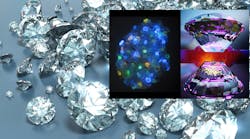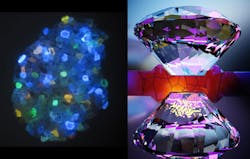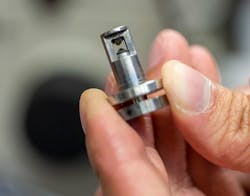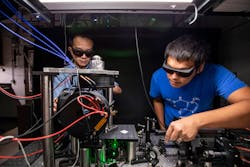Researchers at the Lawrence Berkeley National Laboratory have looked for ways to determine how the properties of electronic and optical materials can be harnessed to develop ultrasensitive sensors for measuring electric and magnetic fields. Their solution? Turning the natural atomic flaws inside diamond anvils into sensors.
Since their invention more than 60 years ago, diamond anvil cells have let engineers recreate extreme pressures such as those deep inside the Earth’s mantle, or to enable chemical reactions that can only be triggered by intense pressure, all within the confines of a laboratory apparatus that can be safely held in the palm of your hand.
To develop new, high-performance materials, scientists need to understand how useful properties, such as magnetism and strength, change under such harsh conditions. But often, measuring these properties with enough sensitivity requires a sensor that can withstand the crushing forces inside a diamond anvil cell.
At the atomic level, diamonds are carbon atoms bound together in an almost perfect tetrahedral crystal. But when diamonds form, some carbon atoms get bumped out of their “lattice site”. When a nitrogen atom impurity trapped in the crystal sits adjacent to an empty site, an atomic defect called a nitrogen-vacancy (NV) center forms. Over the last decade, scientists have used NV centers as sensors to measure the magnetism of a single protein, the electric field from a single electron, and the temperature inside a living cell, explains Berkley Lab scientist Norman Yao.
To take advantage of the NV centers’ intrinsic sensing properties, Yao and colleagues engineered a thin layer of them directly inside the diamond anvil so they could get a quick glimpse of what goes on inside the high-pressure chamber.
After creating a layer of NV center sensors a few hundred atoms thick inside a one-tenth-carat diamond, the researchers tested the NV sensors’ ability to measure pressure inside the diamond anvil cell’s high-pressure chamber.
The sensors glow a brilliant shade of red when excited with laser light. Looking into the brightness of this fluorescence, researchers could see how the sensors responded to small changes in their environment, and what they discovered surprised them: The NV sensors suggested that the once-flat surface of the diamond anvil began to curve in the center under pressure.
“They had known about this effect for decades but were accustomed to seeing it at 20 times the pressure, where you can see the curvature by eye,” Yao says. “Remarkably, our diamond anvil sensor could detect this tiny curvature at even the lowest pressures.”
There were other surprises, too. When a methanol/ethanol mixture they squeezed in the anvil underwent a glass transition from a liquid to a solid, the diamond surface turned from a smooth bowl to a jagged, textured surface. Mechanical simulations confirmed the result.
“This is a fundamentally new way to measure phase transitions in materials at high pressure, and we hope this will complement conventional methods that use powerful X-ray radiation from a synchrotron ,” says lead researcher Satcher Hsieh.
In another experiment, the team used its array of NV sensors to capture a magnetic “snapshot” of iron and gadolinium, both magnetic metals.
Scientists have long known that compressing iron and gadolinium can alter them from a magnetic phase to a nonmagnetic phase, an outcome of what scientists call a “pressure-induced phase transition”. In the case of iron, the researchers directly imaged this transition by measuring the depletion of the magnetic field generated by a micron-sized bead of iron inside the high-pressure chamber.
In the case of gadolinium, the researchers took a different approach. That’s because the electrons inside gadolinium “happily whiz around in random directions,” and this chaotic electron motion generates a fluctuating magnetic field the NV sensor can measure.
The researchers noted that the NV center sensors can flip into different magnetic quantum states in the presence of magnetic fluctuations, much like how a compass needle spins in different directions when a bar magnet is waved near it.
The engineers postulated that by timing how long it took the NV centers to flip from one magnetic state to another, they could characterize the gadolinium’s magnetic phase by measuring the magnetic “noise” emanating from the gadolinium electrons’ motion.
They found that when gadolinium is in its non-magnetic phase, its electrons are subdued, and its magnetic field fluctuations are therefore weak. Subsequently, the NV sensors stay in a single magnetic quantum state for a long while—nearly a hundred microseconds. Conversely, when the gadolinium sample changed to its magnetic phase, the electrons moved around rapidly, causing the nearby NV sensor to swiftly flip to another magnetic quantum state.
This sudden change provided clear evidence that gadolinium had entered a different magnetic phase, Hsieh said, adding that the researchers’ technique let them pinpoint magnetic properties across the sample with submicron precision, as opposed to averaging them over the entire high-pressure chamber a la previous studies.
The researchers hope that this “noise spectroscopy” technique will give engineers a new tool for exploring phases of magnetic matter that can be used as to find smaller, faster, and less-expensive ways to store and process data in next-generation ultrafast spintronic devices.
Now that they’ve demonstrated how to engineer NV centers into diamond anvil cells, the researchers plan to use their device to explore the magnetic behavior of superconducting hydrides—materials that conduct electricity without loss near room temperature at high pressure, which could revolutionize how energy is stored and transferred.



